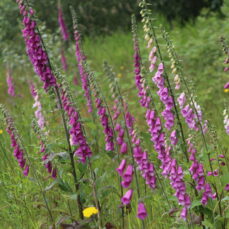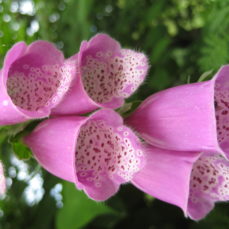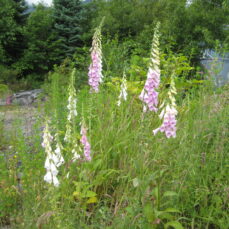
Management Strategy
Squamish
Whistler
Pemberton
Vectors of Spread
Synonyms
- Purple foxglove
ID Characteristics
General: Common foxglove is a biennial or short-lived perennial.
Flowers: Typically pink-purple and bell-shaped, with dark purple spots on the inside. Flowers grow in a column on one side of the stem, but not until the plant’s second year of growth. Flowers can also be white, pink, rose, or yellow.
Stem: Erect, leafy stems that grow between 0.5 m and 1.5 m tall. Stems are densely covered in hairs that become glandular farther up the stem.
Leaves: Lance-shaped and green, with soft, grey-white hairs covering the top and bottom of the leaves. The leaves are 10 – 35 cm long and spiral along the stem. They form a tight rosette at the bottom of the stem and decrease in size up the stem.
Fruit: Egg-shaped capsules, around 12 mm long, that split at maturity. The seeds are 0.5 mm long.
Roots: Fibrous, reaching minimum depths of 15 cm.
Similar Species
Native
Common harebell (Campanula rotundifolia) also has purple flowers, but they are closer to a blue colour and don’t grow in columns along the stem.

Common Harebell (Campanula rotundifolia) Hans Hillewaert
Habitat and Origin
Native to Western Europe, the Mediterranean and Northwest Africa, common foxglove was brought to North America as both a garden ornamental and medicinal plant. It can now be found throughout most of Canada and is abundant in southwestern British Columbia.
Common foxglove is abundant in disturbed areas, noticeably along roads, fields, clearings, gravel pits and forest edges. It thrives in soils high in nutrients and moisture, as well as in medium heat and light.
How it Spreads
Common foxglove is a biennial or short-lived perennial that only produces flowers and seeds in its second year of growth. A single plant can produce up to 5000 seeds a year. Flowers need to be pollinated by bees to produce seeds.
Foxglove’s small and numerous seeds are dispersed by wind, water, contaminated soil and gardening equipment. Common foxglove is also sold in garden stores and nurseries as a garden ornamental, aiding its spread.
Impacts
Health:
- Highly toxic to humans and animals. Can cause serious illness or death if ingested due to the presence of glycoside digitoxin in the leaves, flowers, and seeds.
- Contact with the plant can also cause skin irritation.
Ecological:
- Outcompetes native plants due to the natural succession process.
Stop the Spread
Common foxglove is found in the Sea to Sky region and its distribution is beyond landscape-level control. When Common foxglove is present at high-priority locations and negatively impacting them, their control is considered a high priority.
Otherwise, the goal is to prevent it from spreading to new (uninfested) areas, and to control it where possible to limit its impact on biodiversity.
Learn to identify common foxglove: use the images presented in this profile page to learn how to identify common foxglove.
What to do if you spot it: You can report any common foxglove sighting by visiting our reporting page.
DO:
- Regularly monitor properties for weed infestations.
- Ensure soil and gravel are uncontaminated before transport.
- Check wildflower mixes to ensure that they do not contain common foxglove.
- Ensure that plants are disposed of in a garbage bag if found in floral arrangements to prevent seeds from spreading.
DO NOT:
- Do not unload, park or store equipment or vehicles in infested areas; remove plant material from any equipment, vehicles, or clothing used in such areas and wash equipment and vehicles at designated cleaning sites before leaving infested areas.
- Do not plant common foxglove in a garden, no matter how well-contained its enclosure may seem.
- Do not move soil that has been contaminated with common foxglove.
- Do not compost common foxglove.
Control
Mechanical
Hand-pulling of common foxglove is proven to be the most effective and efficient control method. If hand-pulling, gloves are essential due to the plant’s toxic properties. Ensure that the entire root is removed and that all flowers are bagged. Do not shake the plant when removing flowers, as seeds can be dispersed back into the soil.
Chemical
Trials on chemical control have concluded that metsulfron methyl and triclopyr showed some control on common foxglove. However, hand-pulling is still considered the most effective control method.
We recommend that any herbicide application is carried out by a person holding a valid BC Pesticide Applicator Certificate. Before selecting and applying herbicides, you must review and follow herbicide labels and application rates; municipal, regional, provincial and federal laws and regulations; species-specific treatment recommendations, and site-specific goals and objectives.
Biological
There is currently no biological control for common foxglove due to its toxic properties.
Sea to Sky Distribution
Common Foxglove Factsheet
References
- California Invasive Plant Council, Digitalis purpurea
- Central Coast Biodiversity, Common Foxglove, Digitalis purpurea
- Electronic Atlas of the Flora of BC, Digitalis purpurea L.
- Invasive Plant Atlas, Foxglove
- Invasive Species Council of British Columbia, Foxglove (Digitalis purpurea)
- Pacific Northwest Flowers, Digitalis purpurea
- University of Wisconsin-Madison, Common Foxglove













